Continued from Part 1.
ONE OF ANCHORAGE'S WILD SIDES
Anchorage's slogan is Big. Wild. Life. This is one of its crown jewels.
The first place we stopped this morning on our day trip along the
northern edge of Turnagain Arm was Potter Marsh, a bird refuge and
nesting area right next to the Seward Hwy. south of Anchorage.
Extensive boardwalks and decks allow visitors to get close to the
waterfowl and mammals who call the 564-acre marsh their home or visit it
during migration:
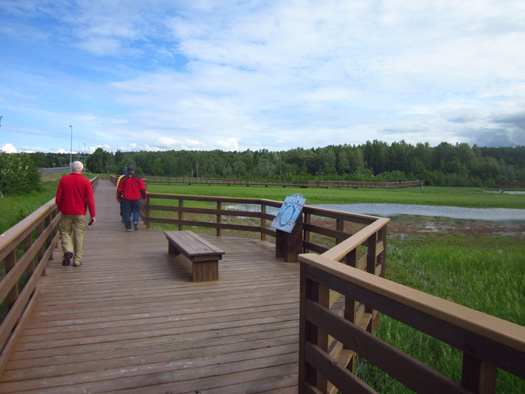
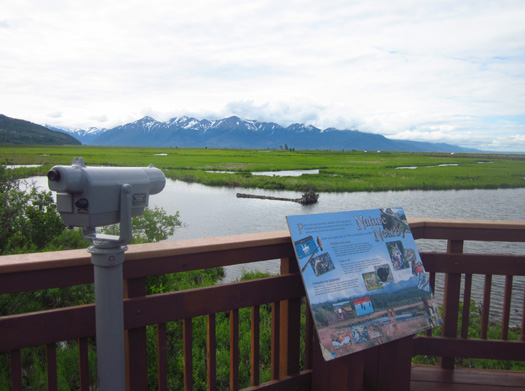
The refuge was established in 1971 to protect fish, birds, and other wildlife
and their habitat, while providing humans with recreational opportunities.
It is one of over
thirty wildlife refuges, sanctuaries, and important habitat areas
managed by the Alaska Department of Fish & Game. We plan to visit
more of them while we're in the state.
Our tourist information books and pamphlets only briefly
describe the Anchorage Coastal Wildlife Refuge, more commonly called
just "Potter Marsh." Most
of the information I'm relating here is from numerous interpretive
panels at the entrance (below) and along the boardwalk:
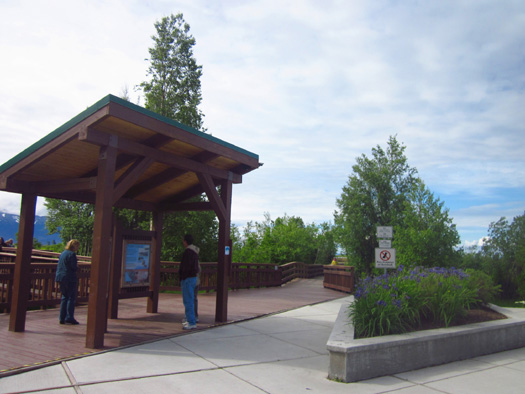
Note: there is
no fee to park or visit any part of the refuge, which is great. This natural haven
provides some of the best free entertainment, enjoyment, and education
in Alaska. We loved it.
Second note:
dogs aren't allowed on the boardwalk over the marsh -- especially
"duck dogs!" (Ha. Cody-the-Labrador-retriever doesn't even know what a
duck is.) Some hunting is allowed in other parts of the refuge at
certain times but not in Potter Marsh.
Because of its
proximity to Anchorage, the number of birds and other critters it attracts from spring
through fall, the general beauty and quiet, and its extensive system of boardwalks that are accessible
to everyone (walking or in wheelchairs), Potter Marsh is one of the most heavily-visited wildlife
sites in the state.
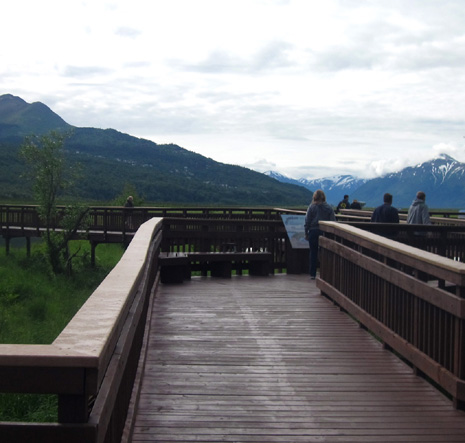
We arrived about 10
AM this breezy, cloudy morning and the parking area was about one-quarter full.
Some of my pictures have people in them but the boardwalks and trails
were not crowded.
We managed to avoid
most of the people by going the other direction or pausing at places
along the boardwalk where they weren't gathered.
From the entrance you
can go in two different directions -- to the south on a long "L"
toward the highway, where much of the open wetland lies, or north toward
the wooded area at the base of the Chugach Range:
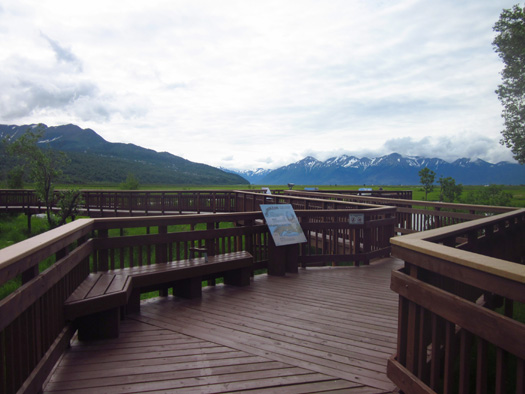
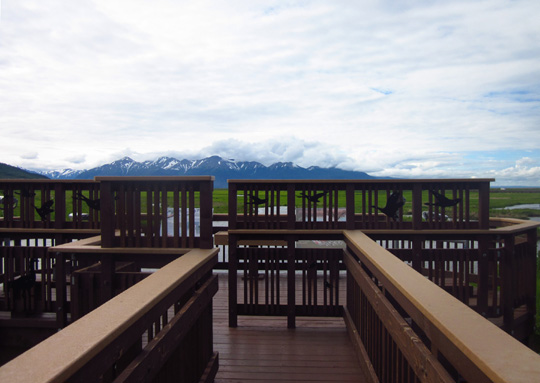
The boardwalk twists
and turns in either direction. It's about a one-mile walk if you go out
and back on both legs.
There are numerous benches, decks extending over
the water, spotting scopes, and decorative touches, like the bird motifs
in the picture directly above.
A SERENDIPITOUS BEGINNING
Potter Marsh is a true rarity because of the way it came into existence.
Although people now realize the benefits of both creating and preserving
wetlands in their communities, they didn't know that early in the 20th
Century.
If it wasn't for the Alaska Railroad this wildlife refuge wouldn't exist
-- or wouldn't have existed until the Seward Hwy. was built in
later years. It was accidentally created in 1916-17 during construction
of the rail line from Seward to Fairbanks along the north side of Turnagain Arm.
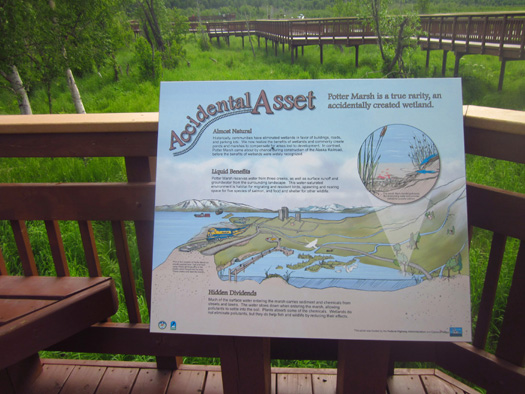
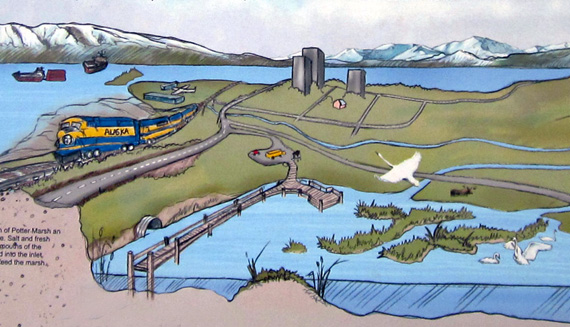
What is now Potter
Marsh lies between the base of the Chugach Mountains and Turnagain Arm,
as depicted in the graphic on the panel above (the mountains are off to
the right).
When the railroad was
being built workers created an embankment for the track. That embankment impounded several creeks and limited tides and storm
surges. What was previously mostly salt water in the original tidal
estuary at this location eventually became mostly
fresh water in the new marsh born behind the embankment.
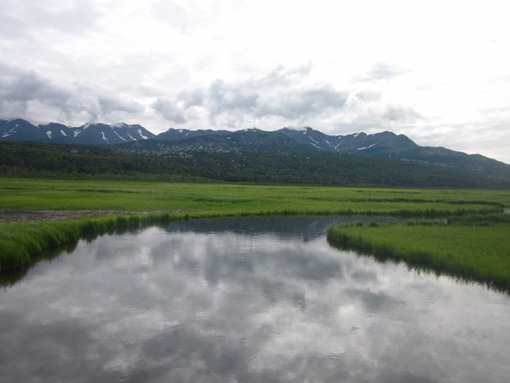
One of the creeks flowing through the marsh
reflects mountains and clouds.
Low areas soon filled with creek water and became freshwater ponds. Marsh
vegetation grew. Both the water and plants attracted migrating waterfowl
and shorebirds, nesting birds, and mammals.
Because over time this marsh fills in with sediment coming down the
mountain streams, human intervention (i.e., dredging) is sometimes necessary
to maintain the water in the wetland. One of the interpretive panels describes
the process of "succession" in which natural environments gradually
change over time. This area is a good example of that phenomenon.
MARSH COCKTAIL
Potter Marsh is now predominantly a freshwater marsh sustained by rainfall,
snowfall, and several creeks flowing down from the Chugach Mountains.
However, the northwestern part of the marsh supports different plants
and animals than the rest of the marsh.
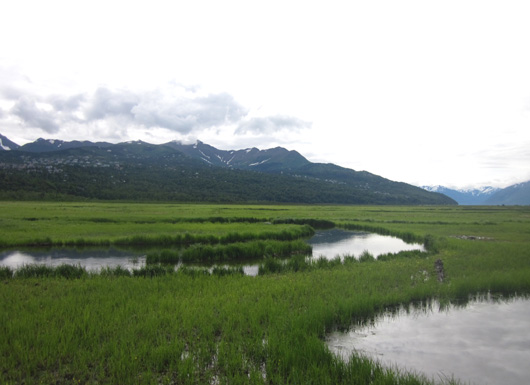
Under new and full moons, when the tides are especially high (and bore
tides are more likely to occur), salt water from Turnagain Arm flows
into the marsh and mixes with the fresh water, forming a brackish, salty
"cocktail."
Only salt-tolerant plants and animals can survive in that part of the marsh.
Humans have also had a hand in maintaining/preserving the habitat in
this area by constructing culverts under the railroad tracks and Seward
Highway, which also runs along the southern edge of the marsh, to
provide an avenue for the fresh and saltwater to mix like it used
to before the embankment changed the dynamics:
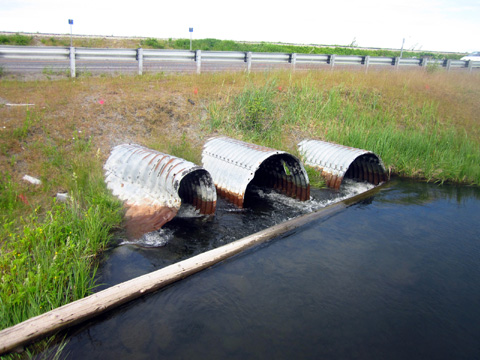
Without the culverts salmon wouldn't be able to return to spawn and
raise their babies, salt-loving plants wouldn't exist, food sources for
brown bears, eagles, waterfowl, and many other animals would be absent,
and Potter Marsh would overflow.
FEATHERED FRIENDS
This morning we saw all kinds of birds flying and nesting in the marsh.
We aren't serious birders so we don't know the names of most of them but
we still enjoyed watching them.
Some species live in the area all year long. Others are temporary
visitors.
Every year millions of birds migrate to and from Alaska from thousands
of miles away. Potter Marsh provides many of these avian ultra-travelers
the habitat they need either in transit to places farther beyond or for a
suitable breeding area all summer long.
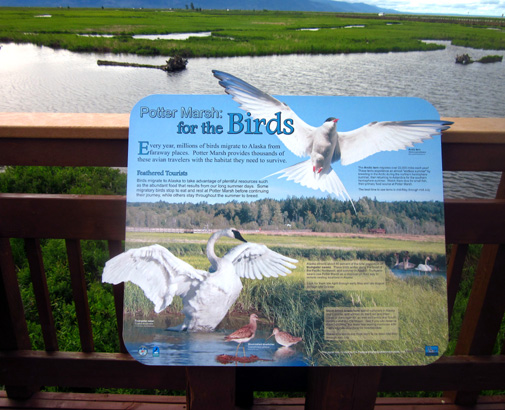
At the entrance to the boardwalk we noted a hand-written dry erase board with the
birds and mammals people have spotted this week.
It was a long list including many that I've heard of (moose, muskrats,
bald eagles, mallards, Arctic terns, Canada geese, sandhill cranes,
ravens, sparrows, swallows, flycatchers, gulls, magpies, juncos,
pintails, teals, gulls, and robins) and some birds that are new to me
-- greater and lesser yellowlegs (medium to large shorebirds),
gadwalls (a kind of duck), and long-billed dowitchers (medium-sized
shorebirds). I had to look those three up.
Several of the interpretive panels describe the birds that live here all
year, only breed here in the summer, or just pause a while during
migration to and from other areas.
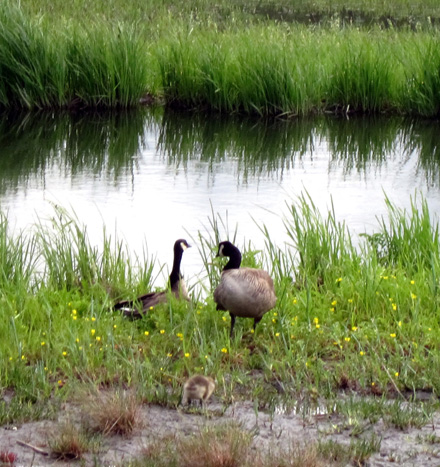
Two geese and a gosling, which is barely
discernable in the foreground
An example of a species that visits the marsh only temporarily during
migration is the trumpeter swan.
Alaska attracts about 80% of the world's population of trumpeter swans.
They winter along the coast of the Pacific Northwest and summer in
Alaska, enjoying the abundance of sunlight and natural resources. Many
swans visit Potter Marsh in the spring and fall on their way to and from
their breeding grounds farther north in the Arctic.
Trumpeter swans can be seen in this area in April-May and
August-September.
Although we missed that window of time here in Anchorage, we did see
some swans farther north in the Yukon and Alaska earlier in the month.
They built their nests on little islands of dirt and grass in the middle
of ponds to keep the babies safe from predators.
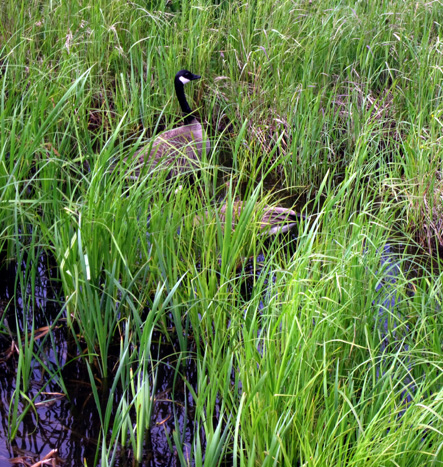
These two geese are harder to see in the tall
grass;
there are probably one or more goslings nearby,
too.
One of the migratory
species that may spend the entire summer at Potter Marsh is the Arctic
tern.
Arctic terns are
probably the ultimate "ultra-distance" migratory birds, flying more
miles each year than hummingbirds. They migrate over 22,000 miles each
year from Antarctica in the southern hemisphere's summer to the Arctic
in the northern hemisphere's summer -- and back again.
They especially like
the fish at Potter Marsh. The best time to see Arctic terns is mid-May to
mid-July. We saw some of them but I didn't get any pictures of them.
With my decidedly low-range digital compact Canon camera
I got some decent photos of a pair of geese close to the boardwalk near
the highway. Their four chicks were little balls of yellow fuzz.
As we walked outbound the chicks were close to one of the parents (in the brown grass
below):
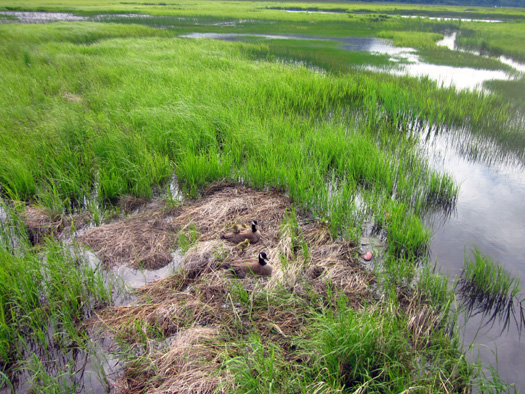
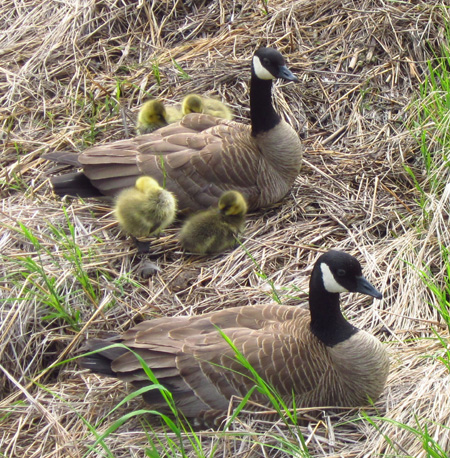
When we came back a few minutes later all four were sheltered under one
of mama's large wings Ė very sweet (and cozy warm):
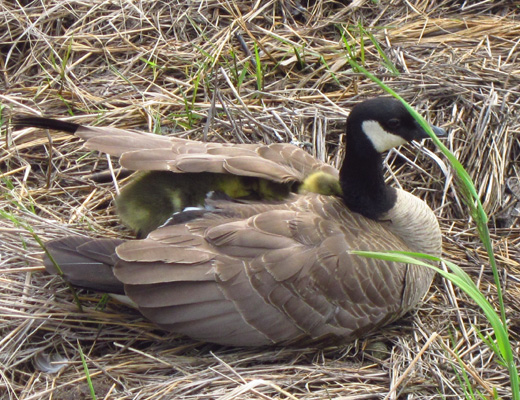
Other interpretive
panels describe the insects, amphibians, and mammals that inhabit this
ecosystem.
One of the more
interesting panels was about the life cycle of wood frogs, which
live in the marsh year-round. They survive the winter beneath the water
by going into a state of suspended animation by producing their own
"antifreeze."
Their bodies replace
the water inside their cells with a syrupy glucose mixture that prevents
dehydration and collapse of the cells while the frogs are hibernating.
The water between the cells freezes, then thaws in the spring
when the temperature warms up. The frogs hop out and breed, enjoying a
rather brief summer of activity before the temperatures drop and they
become frogsicles again.
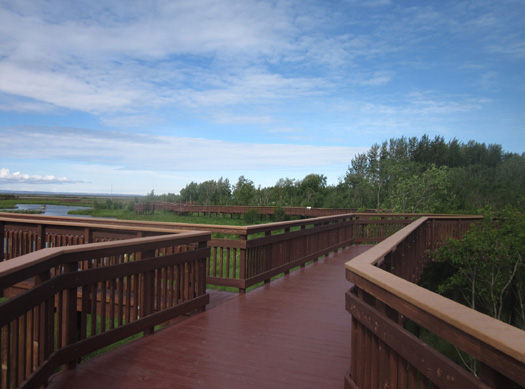
That's a pretty neat Darwinian adaptation, eh?
We weren't able to
see any bears, moose, coyotes, fox, lynx, or even smaller critters like
rabbits on the boardwalk near the forest (photo above) but the views
from back there were so good I
didnít mind:
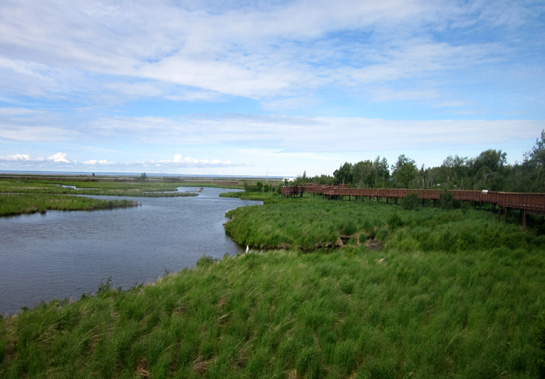
NATURE NEARBY
You don't have to be
a serious birder to enjoy Potter Marsh. It has something to offer almost
any nature-lover who takes the time to visit.
For starters, it's a
nature photographer's dream -- mountains, water, sky, and
interesting plant and
animal life all around:
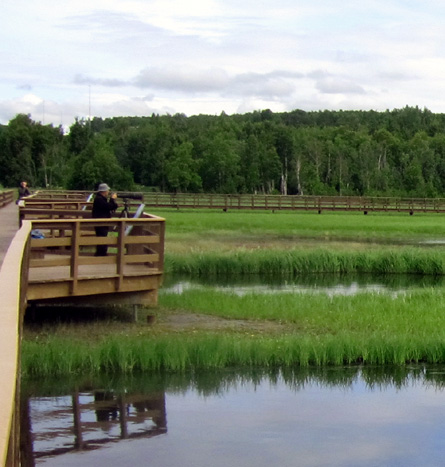
This is a good place to have
strong binoculars or long camera lenses.
In the summer it offers residents and visitors
easy access to all kinds of wildlife and natural habitat, enhancing the
quality of life. It is an outdoor educational area for people of all
ages. When the salmon are running you can observe coho, king, chum,
sockeye, and pink salmon right from the boardwalk.
And despite the
nearby highway, it's a relaxing place to get some fresh air, sunshine,
and a little exercise:
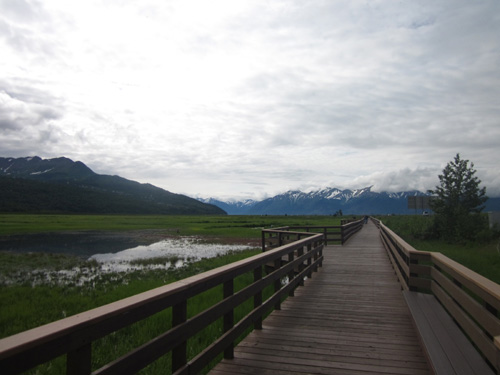
Above and below: a long leg
of the boardwalk parallels pretty close to the Seward Hwy. It
wasn't too
distracting because we were
usually looking the other direction toward the marsh, searching for
birds.
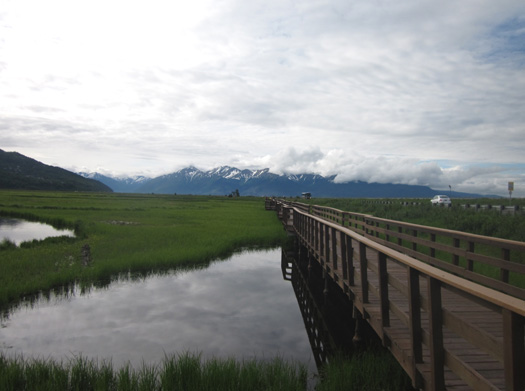
Just bring a camera
and binoculars, a sense of wonder at the natural beauty around you
(mountains, forests, wetlands, ocean), and enjoy a quiet walk out and
back on the two long legs of the boardwalk.
And if you happen to be in Alaska during the winter, frozen ponds in
the marsh allow for ice skating, games of hockey, and cross-country
skiing.
The photography should be pretty "cool" then, too.
ULTRA WILDLIFE TRAIL
If you are a serious birder/nature lover, consider following all or
part of the Kenai Peninsula Wildlife Viewing Trail, which includes 65
sites that Alaska residents deem the best places to view wildlife.
This
collection of sites includes venues that range from easily-accessible roadside platforms to
remote backcountry hikes. You can get a guidebook for the wildlife trail at visitor centers and
bookstores in Anchorage or the Kenai Peninsula.
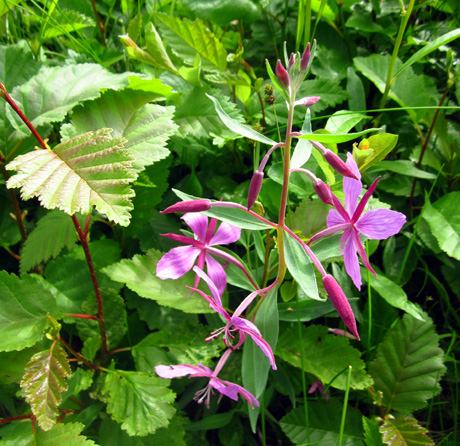
Fireweeds are just opening up
along a dirt trail near the parking area.
I assume there are similar wildlife trails in other parts of the
state, too.
It's possible to spot wildlife almost anywhere in Alaska, even
busy highways. We've seen all sorts of birds and mammals from the road
as we're traveling.
And I've already mentioned how many bears and moose roam around the city
of Anchorage!
Just keep your eyes and ears
open while riding, hiking, or running.
Next entry: our Byron Glacier hike and a visit to
the Begich, Boggs National Forest Service Visitor Center at Portage Lake
(complete with icebergs!)
Happy trails,
Sue
"Runtrails & Company" - Sue Norwood, Jim O'Neil,
and Cody the ultra Lab
Previous
Next
© 2012 Sue Norwood and Jim O'Neil























